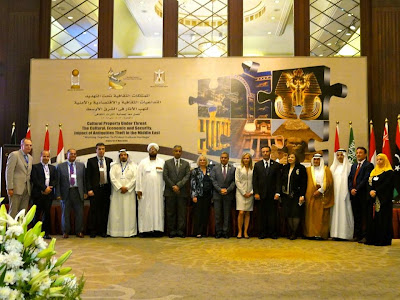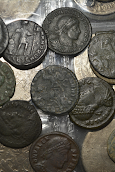Culture Under Threat Conference in Cairo: Red Arch Raises Important Questions Posed by U.S. Imports of Art, Collectors’ Pieces, and Antiques
Why did the declared value of U.S. general imports of antiques over 100 years old from Iraq skyrocket 1302% between 2009 and 2013, from $322,564 to $4,523,126?
These were some of the questions posed by Red Arch Cultural Heritage Law & Policy Research at an historic international summit held in Cairo on May 13 and 14.
Titled Culture Under Threat and cooperatively organized by the Washington, D.C.-based Antiquities Coalition and the Middle East Institute, the conference featured government ministers from ten nations. Together, they signed the Cairo Declaration, a document proposed by Egyptian Minister of Antiquities Mamdouh Eldamaty, calling for:
- the establishment of a high-level task force to coordinate regional and international efforts against cultural heritage trafficking,
- the creation of a public awareness campaign against the black market trade, and
- the formation of an independent center to combat antiquities laundering.
Egypt, Iraq, Jordan, Kuwait, Lebanon, Libya, Oman, Saudi Arabia, Sudan, and the United Arab Emirates proffered the Declaration in the wake of widespread plunder and destruction of archaeological, historical, and religious treasures located in the Middle East and North Africa (MENA).
“Criminal networks and terrorist groups have systematically looted historic sites and profited from the sales of these antiquities in international black markets,” the government ministers decried. They further denounced the sale of “blood antiquities,” which help fund ISIS and other terror groups.
In light of the extensive cultural heritage looting in the MENA region and because transnational commodities traffickers have been known to penetrate complex trade systems in order to turn contraband into cash, international trade data presented by Red Arch Research sparked important discussions among conference participants. The data highlighting U.S. imports of nondescript antiques from war-torn Syria and Iraq may prompt law enforcement and customs authorities to confirm or dispel any suspicions raised by the numbers.
Additional questions posed by the trade data include:
Why did the declared value of U.S. general imports of archaeological, historical, or ethnographic pieces from Egypt jump 105.5%, from approximately $5.2 million in 2012 to $10.7 million in 2013, which made Egypt the #2 source of such commodities by value behind the United Kingdom at $11.4 million?
Why did the declared value of U.S. general imports of archaeological, historical, or ethnographic goods from Lebanon spike 4,483%, from $6,546 in 2012 to $300,000 in 2013?
Why did the declared value of U.S. general imports of collectors’ coins (excluding gold coins) surge
– 82% from Turkey, from approximately $1.7 million in 2012 to $3 million in 2013?
– 417% from Lebanon, from $54,651 in 2012 to $282,434 in 2013?
– 2,604% from Libya, from $4,793 in 2012 to $129,620 in 2013?
 |
| UN Office of Drugs and Crime Regional Representative Masood Karimipour listens as Red Arch Director Rick St. Hilaire addresses the Cairo conference delegates. |
Smugglers have been known to over-value or under-value invoices to disguise money transfers—a practice called trade based money laundering. Criminals also have been known to create shell import and export companies to hide the origins and transfers of illegally trafficked cultural goods. In past years, the CHL blog has chronicled cases where traffickers surreptitiously described Hindu sculptures as “handicrafts” on customs forms, affixed “Made in Thailand” stickers on ancient Ban Chiang pots to make them appear modern, manipulated the description of a Tyrannosaurus bataar skeleton from Mongolia as a fossil reptile from Great Britain on import paperwork, or falsely declared ancient Egyptian artifacts as “original sculptures and statuary” from Turkey, the UAE, and other nations. These cases illustrate the Basel Art Trade Guidelines (2012) warning that:
In comparison with other trade sectors, the art market faces a higher risk of exposure to dubious trade practices. This is due to the volume of illegal or legally questionable transactions, which is noticeably higher in this sector than in other globally active markets. Far more serious than shady dealings in a legal grey area, the sector’s shadow economy encompasses issues ranging from looted art, professional counterfeiting and fake certificates to the use of art sales for the purpose of money laundering.
Because the legal art and antiquities marketplace nurtures opacity, placing excessive emphasis on discretion over transparency, a black market temptation exists among smugglers, fences, and launderers to hide drops of illegally acquired goods deep within the sea of legitimate commerce. And the sea is vast. Declared American imports of art, collectors’ pieces, and antiques alone totaled over $9 billion in 2013, crowning the U.S. as the top global importer of commodities classified by this customs heading.
Answers are required to the critical questions lurking behind the import statistics: Who is importing the cultural heritage material? Who are the exporters? Exactly what “antiques,” “archaeological pieces,” and “collectors’ coins” are being shipped to the U.S.? From which archaeological sites and through what transshipment countries? And which imports are legal versus illegal? Indeed, uncovering black market trading pipelines, supply chains, and distribution networks navigating within the legitimate stream of commerce should be a key goal of the Cairo conference delegates as well as INTERPOL, the World Customs Organization, dealers and auction houses, and other stakeholders.
________________________
Invaluable research assistance supplied by Keegan Trace Brooks, JD Candidate, Georgia State University. Data assembled by Red Arch Research from statistics collected by the U.S. Department of Commerce and the U.S. International Trade Commission. Photos courtesy of the Antiquities Coalition.
Copyright note: Although the data presented here is sourced from publicly available information, it has been carefully selected, coordinated, arranged, and analyzed so that it is subject to copyright as a compilation by CHL. The publication, retransmission, or broadcast of this compiled data is strictly prohibited without CHL’s express consent.
Text copyrighted 2015 by Cultural Heritage Lawyer. Blog url: culturalheritagelawyer.blogspot.com. Any unauthorized reproduction or retransmission of this post without the express written consent of CHL is prohibited. CHL is a service of Red Arch Cultural Heritage Law & Policy Research, Inc.



